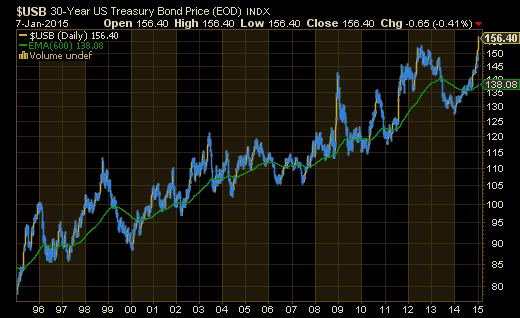I’ve been a bond bull for as long as I’ve written this blog. Over the course of the last 6 years I’ve repeatedly defended bonds in a portfolio, explained why US government bonds were not at risk of default or high inflation and I’ve spilled a huge amount of ink trying to explain why bonds weren’t in a “bubble” (see here) and why the high probability of low inflation could lead to the continuance of the bond bull market. With the exception of a few brief periods (such as late 2008) I have had substantial long positions in bonds. I’ve had a change of heart lately and I want to explain my thinking here.
The 10 year US T-Note reached a yield of 1.97% in trading this week. That’s down from a high of 3% in early 2014. That equates to roughly a 12.5% price gain in the 10 year. This is due, in large part, to collapsing inflation expectations and fears over the state of the global economy. But let’s explore the rationality of such bond pricing.
A lot of people don’t know that bonds have prices just like stocks do. For whatever reason no one seems to focus much on bond prices. Below is the 20 year price performance of a 30 year T-Bond:
I added a moving average for some perspective because bond prices are generally pretty stable. As you can see, bond prices tend to be mean reverting because big swings in the price tend to result in an unsustainable mispricing. I’ve referred to this occurrence as “price compression” – that is, behaviorally biased investors will tend to price in many years worth of appreciation in a brief period which creates an instability in the markets. And if those expectations end up being even remotely wrong then the price is at risk of correction. A 10 year note yielding 1.97% isn’t going to generate a 12.5% return every year for the next 10 years. The basic math just doesn’t work. So we’re starting to see a near-term price compression at work.
Of course, bond prices are the inverse of interest rates and there’s no reason why interest rates can’t continue to decline. And if the 10 year note yield declines to its lows of 1.4% then we’ll see a further 7% appreciation. But what are the odds of this happening and does this make for a sensible risk/reward trade? 2 year break-evens in the USA are now negative meaning that noflation has been priced into prices in the near-term. And while there’s certainly some frightening occurrences in the global markets there does not appear to be strong signs of deflation in the USA. Unlike the 2008 period when I was very worried about deflation there are virtually no signs that prices could actually begin deflating in the USA. Continued low inflation – yes, but deflation – no. In fact, some indicators like the Employment Cost Index are showing signs of inflation running hotter than many think.
Is there some chance that we will see the all-time lows in 10 year notes at 1.4%? Of course. But we’re talking about a worst case scenario type of environment where deflation is setting in, recession is likely occurring and some very serious tail risk event sets in. And in that scenario you’re getting a measly 7% annual return in what should be the safest asset class on Earth. If, on the other hand, the deflationary beliefs are wrong and interest rates rise to 3% then you will experience a 7% annual decline in the 10 year. Said differently, a bet on all-time low rates is a bet on a disaster scenario that will pay off to the tune of just 7%. If, on the other hand, the US economy is stronger than some think and inflation is running a little hotter than most presume then that means bond traders will be caught flat footed and rates could shoot higher. Personally, I don’t see a high probability of the deflation scenario playing out. In fact, the slow and steady recovery scenario looks much more likely to me. And that makes this a bit of an asymmetric trade at present.
I’ve defined a bubble as an environment in which an asset’s price has deviated from its underlying fundamentals to the point that its current price becomes unstable relative to the asset’s ability to deliver the expected result. I am hesitant to call bonds a “bubble” here as that implies a significant risk of substantial price declines, but I would call bonds frothy here. There appears to be an extremely negative environment being priced into bonds that is unlikely to play out or persist. So bonds are not a bubble, but their frothiness means bonds are riskier than their current prices imply.
Mr. Roche is the Founder and Chief Investment Officer of Discipline Funds.Discipline Funds is a low fee financial advisory firm with a focus on helping people be more disciplined with their finances.
He is also the author of Pragmatic Capitalism: What Every Investor Needs to Understand About Money and Finance, Understanding the Modern Monetary System and Understanding Modern Portfolio Construction.

